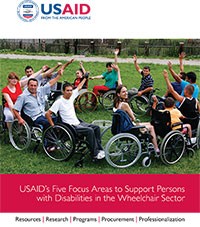- What We Do
- Agriculture and Food Security
- Democracy, Human Rights and Governance
- Democracy, Human Rights and Governance Strategy
- Supporting Free and Fair Elections
- Supporting Vibrant Civil Society & Independent Media
- Protecting Human Rights
- Promoting Accountability & Transparency
- Importance of Democracy, Human Rights, & Governance to Development
- COVID-19: Issues and Potential USAID Responses
- Countering Trafficking in Persons
- Global Labor Program
- Religious Freedom
- Youth Impact
- Economic Growth and Trade
- Education
- Environment and Global Climate Change
- Gender Equality and Women's Empowerment
- Global Health
- Humanitarian Assistance
- Transformation at USAID
- Water and Sanitation
- Working in Crises and Conflict
- U.S. Global Development Lab
Speeches Shim
The Center of Excellence on Democracy, Human Rights and Governance Human Rights Team houses the Programs for Vulnerable Populations, which works to reduce risks to vulnerable populations and to help communities, non-governmental organizations, and governments provide services and protection for at-risk groups. Through these programs, vulnerable populations gain access to opportunities that support their full participation in society.
The Programs for Vulnerable Populations contributes to the Agency’s goal of protecting the human rights and developing the capacities of vulnerable populations worldwide. In doing so, our programs help prevent conflict, spur economic growth, and advance human dignity.
Our Work
The Programs for Vulnerable Populations comprises five congressionally directed programs:
Displaced Children and Orphans Fund
The Displaced Children and Orphans Fund (DCOF) provides care and protection to vulnerable children, particularly those separated from their families or are at risk of losing family care, including:
- Children in institutional care
- Children affected by war
- Children on the street
- Children with disabilities
DCOF’s programs help families and communities respond to the special physical, social, educational, and emotional needs of at-risk children. Our child protection programs work in more than 30 countries, reaching over 130,000 children worldwide.
The Displaced Children and Orphan Fund was a key participant in building the National Action Plan for Children in Adversity, a government-wide plan to elevate the importance of children and coordinate services for them.
Leahy War Victims Fund
The Leahy War Victims Fund (LWVF) helps people with disabilities in conflict-affected countries by establishing and improving accessible and appropriate prosthetic, orthotic (P&O), and physical rehabilitation services. Since 1989, our programs have:
- Established and helped sustain P&O workshops
- Promoted professional training, standards, and accreditation for rehabilitation professionals
- Increased mobility and physical functioning of survivors of war and conflict
The LWVF is committed to investing in appropriate prosthetic, orthotic, and physical rehabilitation services, while also emphasizing overall rehabilitation programming. Through the programs, physical rehabilitation services are provided in more than 40 countries.
Victims of Torture Program
Victims of Torture Programming Guidelines
This technical guidance is intended to inform the field on victims of torture programming:
The Victims of Torture Program (VoT) provides treatment and rehabilitation of individuals, families, and community members who suffer from the physical and psychological effects of torture and trauma.
Five principles guide the programming for torture survivors:
- Improve access to and quality of services available to torture-affected communities
- Target individuals who suffer reduced function due to direct or indirect exposure to torture
- Build on existing community networks and resources
- Break the silence experienced by individuals and communities affected by torture
- Expand knowledge on the needs of torture and trauma-affected populations and the effectiveness of treatment
Because treatment interventions vary so widely, the VoT program emphasizes the importance of research to ensure high standards are met in treating torture survivors. Over the past four years, VoT has supported randomized control trials, which have demonstrated that certain interventions improve the functioning and health of torture survivors.
Wheelchair Program
Wheelchair Product Table
Download the product table (pdf, 1mb)
The Wheelchair Program improves the availability of, access to, and sustainability of programs that provide appropriate wheelchairs in the developing world. We believe a number of fundamental principles should be applied to the production and provision of wheelchairs:
- Products should be appropriate to the environment and the individual
- Local services should be sustainable
- Training for service providers and wheelchair riders is essential
- Impact of the programs should be measured by the improvement in the quality of life of wheelchair riders
In 2007, USAID collaborated with the World Health Organization and the International Society for Prosthetics and Orthotics to develop Guidelines On The Provision Of Manual Wheelchairs In Less Resourced Settings. These guidelines continue to be the definitive resource for wheelchair providers in the developing world on the design, production, supply, and service delivery of manual wheelchairs for users in less-resourced settings. We are now working with the World Health Organization to produce and deliver a series of training packages on the provision of wheelchair services.
Disability Program
The Disability Program invests in disabled people’s organizations and organizations that work with them to advance disability rights worldwide. Our programs are cross-cutting and respond to a variety of human rights issues.
Since 2005, disability funding has supported more than 100 programs and activities in over 50 countries working with development partners to:
- Improve national laws and policies to further the rights of people with disabilities
- Increase the numbers of children with disabilities attending school and improve the quality of instruction they receive
- Provide job training to youth with disabilities and open up opportunities for competitive employment
- Train humanitarian relief workers and first responders to better incorporate the needs of people with disabilities in disaster risk reduction
Learn more about our approach to disability-inclusive development
For more information, contact Robert Horvath, Manager, Programs for Vulnerable Populations
Resources and Links
Empowerment and Inclusion Division briefer in pdf format
Children in Adversity/Displaced Children and Orphans Fund briefer in pdf format
Leahy War Victims Fund briefer in pdf format
Wheelchair program briefer in pdf format


Comment
Make a general inquiry or suggest an improvement.